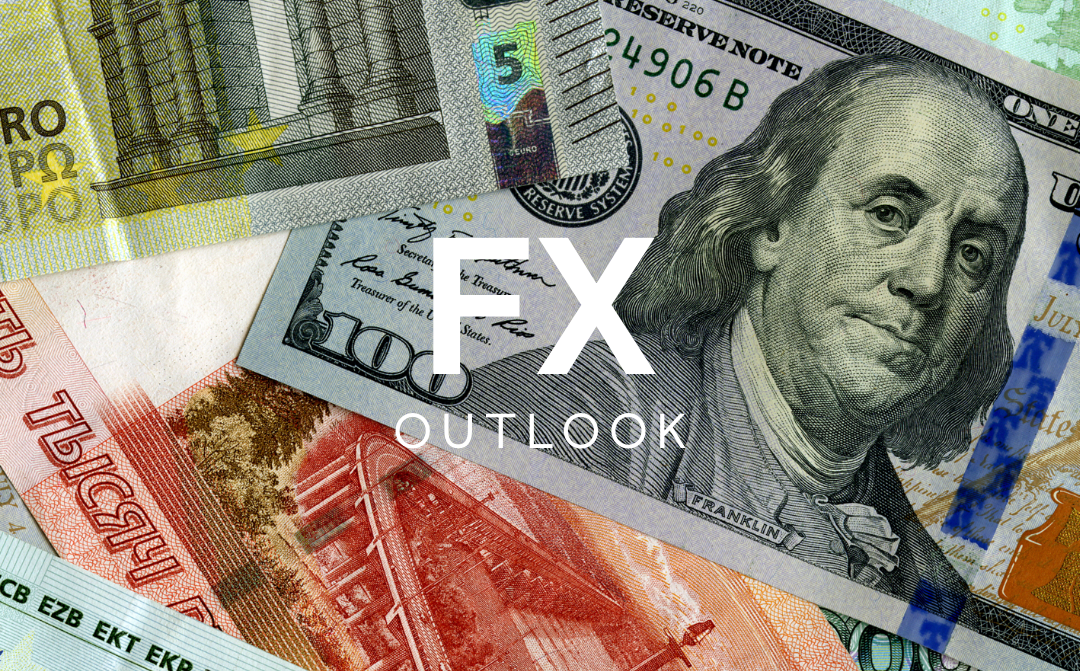18 Dec FX outlook – USD, EUR, GBP, CAD, AUD, NZD

Table of Content
US dollar (USD)
The value of the US dollar fell further after the Federal Reserve said that it would lower borrowing costs by 2024. The dollar index, which measures the performance of the US dollar, fell to a four-month low on Thursday, before staging a late recovery to settle at 102.59. The dollar unfortunately took the bottom spot over the course of the week, with a dovish assessment on Wednesday driving outflows from this haven currency.
Last week was very busy as investors were looking for guidance on the next policy decisions of major central banks. While many question whether US inflation will reach its target by March, the Federal Reserve appear ready to embark upon a raft of rate cuts next year according to the update dot plot. Tuesday’s inflation data highlighted that slow move towards target, with headline CPI falling from 3.2% to 3.1%. However, the core figure continues to remain a problem, with the month figure of 0.3% serving to highlight the strong chance that it remains well above 2% by the time of the expected March rate cut. While the Fed left its interest rates unchanged as expected (5.50%), it was mentioned that from 2024, they will embark on rate cuts of at least 75bps. This led to the tumbling of the US dollar, with equities and precious metals taking advantage. Also, a mixed reading from the US PMI surveys added further pressure to the greenback. However, the US dollar managed to cut back some losses after a Fed member, John Williams talked down on the early expectations of the interest rate reduction, citing that the committee are actually yet to discuss rate cuts.
Looking ahead, the US dollar looks set to remain at the whim of wider market sentiment, with any data that confirms Powell’s dovish outlook expected to drive the dollar lower. The US final GDP which is due on Thursday is expected to remain unchanged at 5.2%. While we will see some sensitivity to the likes of the consumer confidence, unemployment claims, and consumer sentiment data, all eyes will be on the key core PCE inflation figure. With the Fed historically favouring this gauge as their top inflation metric, a notable decline could drive further dollar weakness on the expectation of a more dovish Fed.
Euro (EUR)
The euro enjoyed a somewhat mixed week just gone, with sentiment largely driven by the FOMC and European Central Bank monetary decisions. While a dovish Federal Reserve helped lift EURUSD into a fresh December high, the euro struggled to maintain its post-ECB gains and instead lost ground against the likes of the AUD, NZD, and CAD.
Last week saw the euro currency received a boost on Thursday thanks to a surprisingly hawkish European Central Bank (ECB) outlook on Thursday. Coming in the wake of the dovish FOMC meeting, Christine Lagarde appears unwilling to admit the possibility of the sharp dovish pivot being predicted by markets. While we saw the ZEW economic sentiment figure come in better-than-expected (23), the eurozone economy remains under pressure as highlighted by the latest manufacturing (44.2) and services (48.1) PMI surveys released on Friday. With these surveys signalling a contraction within the eurozone, there is likely to be pressure on the ECB to change course as inflation heads down towards target in the coming months.
Investors are eagerly awaiting more updates on disinflation for the new week to support the ECB’s campaign against inflation. Unfortunately, this week’s CPI figures are revisions and thus look unlikely to cause too much volatility. Additionally, keep a close eye out for additional signs of strength or weakness from the German business climate and consumer confidence reports, which should help guide expectations for the ECB going forward.
British pound (GBP)
The pound experienced a somewhat changeable week, which should come as no surprise given the sheer amount of notable data released over the course of the week. For the most part, the pound struggled to gain traction against many of its peers, with EUR, CAD, AUD, and NZD all gaining ground on the currency over the course of the week. However, a surprisingly dovish FOMC outlook helped boost GBPUSD, which rose to the highest level since August thanks to a risk-on shift away from the dollar.
Last week saw a raft of top tier data released, kicking off with the jobs report on Tuesday. A greater than expected decline in the average earnings figure did help ease inflation concerns somewhat, although this figure remains highly elevated compared with both headline (4.6%) and core (5.7%) inflation. While a lower-than-expected claimant count reading did allay fears around any signs of economic distress in the jobs market, Wednesday saw concerns rise once again as October GDP fell to a three-month low of -0.3%. Could this push the Bank of England into a more dovish stance despite elevated inflation levels? Well markets did not have to wait long for the answer, with the BoE rate decision seeing Bailey take a steadfast approach to bringing down inflation. Markets are looking for a more protracted rate pause from the BoE next year as we await a return to target for UK CPI. With the MPC voting 6-to-3 in favour of a rate pause, we are likely to see rates remain steady for some time yet. Finally, the week was wrapped up with the latest PMI survey, with this leading indicator serving to highlight the current robust standing of the economy, largely thanks to a strengthening services sector (52.7). Unfortunately, the strength of this sector could prove a sticking point when it comes to driving down inflation, with input cost inflation rising to the highest level since August.
Looking ahead, the data continues to come thick and fast in the UK, with inflation and retail sales figures expected to drive sentiment as we head into the festive period. Wednesday’s inflation report will undoubtedly provide the highlight, with any particularly strong slump in CPI bringing potential GBP weakness as markets bring forward expectations for the first hike next year. Last month’s 4.6% figure remains well above the 2% target, and thus we need to see continued progress if the BoE are going to shift onto a more dovish stance. However, the core CPI figure provides an even more worrying picture, with the October figure of 5.7% expected to tick only marginally lower. Meanwhile, Friday’s retail sales figure should provide a strong indication over shopping behaviours around the Black Friday and Cyber Monday sales period in November, providing a gauge of consumer demand at perhaps the most important time of the year for retailers. With retail sales providing a good idea of demand in the face of higher prices, a strong figure could provide a warning sign that consumer remain willing to pay ever higher prices.
Canadian dollar (CAD)
The Canadian Dollar remained one of the top-performing currencies for the week, thanks to the Bank of Canada’s hawkish rate hold and a Thursday rise in oil prices. The CAD enjoyed plenty of upside against the USD, as haven outflows helped drive the greenback to the bottom of the pile. However, we also saw the Canadian dollar gain ground against the likes of the euro and pound thanks to a sharp surge in energy prices towards the end of the week.
Oil, a significant export of the Canadian economy, has broken a seven-week losing trend, propelled by concerns around potential supply constraints in the Red Sea. With BP now following a raft of container shipping firms in diverting their vessels around Africa to avoid further Houthi attacks, we are looking at a significant uptick in the cost and time of deliveries for exports going forward. Fundamentally, there are still concerns about diminishing demand as high interest rates hinder demand. Nonetheless, the recent spike in ships being diverted away from this key route will likely provide the potential for further energy upside over the short-term. Another factor that boosted the CAD was the recent comments by the BOC Governor, who claimed that it was too early to begin cutting interest rates because inflation remained over the central bank’s target.
Moving forward, the CAD will face a slew of important drivers in the coming week, beginning with the Canadian CPI. Markets are expecting to see continued progress after last month’s slump to 3.1%, with the Canadian dollar likely to suffer if we see prices fall sharply. Alternatively, a stronger inflation number will support the BOC’s rate-hold stance, strengthening the CAD. Furthermore, the monthly GDP data will be released on Friday, with the preliminary November figure of 0.2% highlighting why the Bank of Canada will likely continue to remain steady in a bid to drive inflation back down to target. On the energy-front, any further announcements that oil companies will pause the movement of vessels in the red sea would likely boost crude prices and thus the CAD.
Australian dollar (AUD)
The Australian dollar enjoyed a strong week just gone, with a mid-week surge in risk assets helping to lift this currency once again. The dovish stance taken by Jay Powell helped provide a sharp leg higher for AUDUSD, although that also extended to a number of other currency pairs as the Aussie dollar gained ground against GBP, EUR, CAD, and NZD. This saw AUD enjoy the mantle of top performing currency (of those mentioned here).
From an economic standpoint, it felt like the biggest driver came from the US in the form of the Federal Reserve meeting rather than anything Australia specific. That being said, we saw the RBA governor take on a largely confident approach on Monday, with her latest comments signalling a confidence that they are on the right path when it comes to fighting inflation. Meanwhile, Thursday saw the latest jobs data released, with a surge in employment (61.5k) making up for an unwelcome rise in both November and October unemployment figures.
Looking ahead, this week is relatively quiet in terms of Australian data, with wider risk sentiment likely to be the main driver of AUD performance. Nonetheless, we will be watching out for the latest meeting minutes on Monday night, coming hot off the back of last week’s comments from Bullock. Tuesday also sees the latest leading index, which provides a key assessment over the health and direction of the Australian economy.
New Zealand dollar (NZD)
Just like the Australian dollar, NZD enjoyed plenty of upside last week as pro-cyclical currencies enjoyed a leg higher thanks to a dovish FOMC meeting. Much like their neighbour, NZD gained ground against European currencies EUR and GBP, although NZDUSD certainly grabbed the headlines given the weakness of the greenback over the course of the week. Things proved a little less fortunate against the likes of the Canadian dollar and Australian dollar which both gained ground against the Kiwi.
Last week saw a surprisingly weak economic growth figure from the New Zealand economy, with the country contracting by -0.3% in the third quarter. We also saw a substantial downward revision to the second-quarter figure, which was slashed from 0.9% to 0.5%. Will this give the RBNZ food for thought when it comes to their assessment over interest rates going forward? A raft of data from China on Friday did help lift the outlook for this key New Zealand export market, although the gain in Chinese retail sales (10.1%) came in short of expectations.
Looking ahead, this week has precious few events of note to watch out for. The lack of any top tier data releases will see trade balance, business confidence, and global dairy prices take the headlines. However, the high likeliness is that wider risk sentiment will be the most important driver of NZD volatility, with contradicting statements from Fed members Powell and Williams bringing greater sensitivity to any shift in the outlook for US rates. With that in mind, Friday’s US core PCE price index figure will be key for risk assets such as the NZD.
Disclaimer: This material is a marketing communication and shall not in any case be construed as an investment advice, investment recommendation or presentation of an investment strategy. The marketing communication is prepared without taking into consideration the individual investors personal circumstances, investment experience or current financial situation. Any information contained therein in regardsto past performance or future forecasts does not constitute a reliable indicator of future performance, as circumstances may change over time. Scope Markets shall not accept any responsibility for any losses of investors due to the use and the content of the abovementioned information. Please note that forex trading and trading in other leveraged products involves a significant level of risk and is not suitable for all investors.







